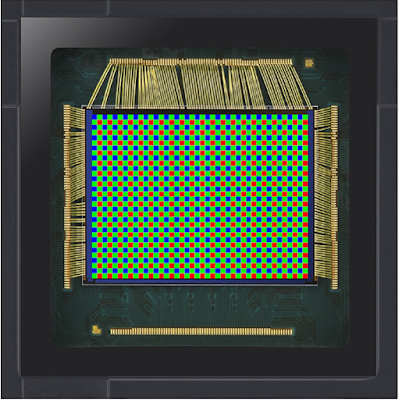
It is no exaggeration to say that the biggest change in the Samsung Galaxy S20 series is on the camera. In particular, the Galaxy S20 Ultra is equipped with 110 million pixels and 100 times digital zoom. This is due to changes in the image sensor. Unlike the existing one, the area has been enlarged and the technology to prevent the deterioration of quality has been widely used. It's still small, but in the end, it was forced to grow in size to improve performance.
The image sensor mounted on the Galaxy S20 Ultra is based on Samsung's recently developed 'Iscell Bright HM1'. It contained 118 million pixels in an area of 1 / 1.33 inches. The simple resolution is 12,000 pixels horizontally and 9,000 pixels vertically. The current offering of the largest number of pixels in the 35mm film format is Sony's Alpha 7R Mark 4, which is more than 71 million pixels (9,504 pixels by 6,336 pixels).

A typical image sensor follows a Bayer pattern format in which pixels of red, blue, green, etc. are arranged in a mosaic form. There are some exceptions (Foveon), but most image sensors are designed in Bayer format. In general, RG / GB pixels are grouped to process information. However, all the dots are black and white pixels that only detect brightness, and the actual dots are colored filters on the black and white pixels.
Samsung Electronics has accumulated a total of 180 million pixels. The size of the pixel is 0.0008 mm in terms of 0.8 micrometers. Using this simple calculation, a sensor measuring 9.6mm in width and 7.2mm in length is created. The 1-inch sensor is about 12.8mm wide and 9.6mm long, so it can be measured to some extent.
Although small, the sensor supports effective shooting day and night because of its 'Nonacell' technology. Nona here means 9, and the key is to get 9 more pixels into the sensor to get more light. The larger the light-receiving area, the more advantageous for information processing. Through this, the Galaxy S20 Ultra can obtain a high-resolution output of 18 million pixels or high sensitivity of 12 million pixels depending on the situation.
This raises a small question. Under normal Bayer pattern sensors, it is not possible to make 9 sensors by combining surrounding pixel information by any means. The color filter itself is an immutable physical element. So how did the Isocell Bright HM1 sensor record 18 million pixels and 12 million pixels high sensitivity results?

This can be found in some of the information disclosed by Samsung Electronics. Information in the Samsung newsroom states that the new image sensor achieves high image quality by switching between pixel rearrangement (re-mosaic) and 9-pixel batching (Nona-binning). The high quality of the two approaches is approached in different meanings, but to provide the best quality in each environment.
From here, the ISOCELL bright HM1 sensor is expected to be placed in the form of Nonacell from the outset. Nine RG / GB pixels arranged in pairs. If you need a lot of light in a low-light environment, it will be united as it is, increasing sensitivity, and conversely, if there is enough light to record high-resolution images, each information will be rearranged and converted to 180 million pixels.
The structure chosen for the effective use of small sensors has obvious advantages. One is high capacity but high-resolution recording, the other is a low resolution but the best image quality at night. The advantage is that both provide satisfactory records.
The problem arises not with the 9-pixel grouping but with the pixel reordering process. Increasing sensitivity and recording 12 million pixel images is relatively difficult. On the other hand, the nine pixels that are clustered together require high processing speed and sophisticated pixel array algorithms to produce high-resolution images. How well did Samsung solve this problem? The release of the Galaxy S20 Ultra is getting closer.
![[Review] Canon EOS-1D X Mark III, 2020 Edition 'End King' DSLR Camera data:post.title](https://blogger.googleusercontent.com/img/b/R29vZ2xl/AVvXsEjzeCR_-TPKj7GzvXQIGc1lM5Hj_J0ZiSWox4AAthLeL1iAPbFbQb4tzpgWHlb51V4PPQoRMiJ_2GECa51S_uGmEgC4KjqMKdBHrgAhyphenhyphenW2aK5DQE5FNLOAaRB7WyHNz_v_KfcguFD9PSmCA/s72-c/0.jpg)


![[Review] Fit for esports gamers, Asus VG248QG data:post.title](https://blogger.googleusercontent.com/img/b/R29vZ2xl/AVvXsEjhHpZcqqsaTPaQvOuy7661F2plo_Av6gvMB9AqZMs9efVHVI6fYvsHcrqPFsyFdw_HuNzLBPM0OVIVUpsO1KxsHcL49mjbE_qzburcoVKllogfO6y62r_c_i-KLJms9_W9ZJy_ZpVm_D3o/s72-c/Asus+VG248QG%252C+0.5ms+response+time+at+165Hz+is+key.5ms+response+time+at+165Hz+is+key.jpg)